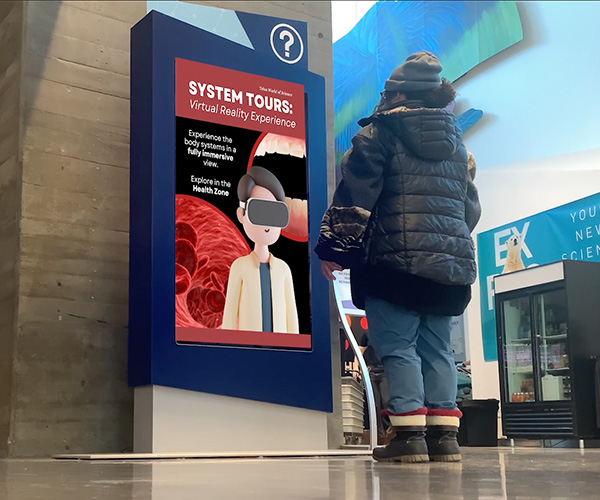For Dr. Farzan Baradaran Rahimi, learning is anything but passive. The assistant professor of design and Tier II Canada Research Chair in Immersive Learning focuses on placing all kinds of learners – from university students to families enjoying a day at the museum – in simulated experiences that feel very real.
Using three different types of technology – reality capture that digitizes real-world environments, artificial intelligence (AI) and extended reality (virtual, augmented and mixed) – he builds strategies to create immersive learning experiences that include anything from play spaces to narrative- and game-based approaches.
In a recent episode of the Office of Research Services’ Research Recast(ed) podcast, Dr. Rahimi told host Kelsie Johnston (formerly Kelsie Howlett) about how his design class teamed up with the Telus World of Science Edmonton (TWOSE) and ELIXR Simulations in the Fall 2024 term. Students split into groups, developing experiences using technologies and strategies in two categories: exploration and navigation.
In one navigation-based project, students handed AI smart glasses to science centre visitors when they arrived, inviting them to engage with a flying AI-powered robot that asked them what they wanted to explore.
“Based on the interaction, the AI would tailor a personalized route through selected exhibitions aligned with their interests,” says Dr. Rahimi. “As visitors moved through the space, the robot interface provided contextual information about exhibits and explained how they were connected.”
Another student group focused on exploration using an augmented reality mirror to provide science centre visitors with expanded information on wildlife in the Arctic. As they entered the exhibit, guests used their smartphones to connect to the mirror, then selected an Arctic animal which appeared alongside them.
“Visitors saw themselves reflected alongside the animal, could interact with it, observe its habitat and even take photos with it,” says Dr. Rahimi. The experience, he adds, turned passive observation into an interactive and memorable learning experience.
While Dr. Rahimi and the Immersive Learning Institute reside within MacEwan’s Bachelor of Design program, he is also working toward creating a minor in immersive learning – the first of its kind in Canada – that will extend beyond his home faculty and bring students together across disciplines.
“As a student in science, one might like to think about a problem linearly – addressing it one step at a time,” he says. “But having students working together from science, nursing, design and business means they can learn from each other and think about a single problem or challenge related to immersive learning iteratively and from multiple perspectives.”
Creating connections is a key part of Dr. Rahimi’s role as both Tier II Canada Research Chair and founder and director of the Immersive Learning Institute, which has him reaching out and building teams of researchers, community partners and industry partners across the country and beyond.
In a recently published paper, Dr. Rahimi and colleagues at the Université Laval looked at using reality-capture technologies, deep learning and extended-reality technology to preserve and digitize cultural heritage, including the Escalier St-Joseph, located in the Québec Seminary National Historic Site of Canada.
Not only does creating a digital twin of a building like the Escalier St-Joseph create opportunities for immersive learning, but it can also generate knowledge that will help preserve buildings at risk.
“Issues including climate change, extreme weather and war threaten historic buildings,” says Dr. Rahimi. “Digitizing creates opportunities to reconstruct and rebuild parts if they are damaged or demolished, and the method we’re developing makes it possible to capture and digitize many of those buildings in a short amount of time.”
 Capturing images in the Escalier St-Joseph in the Québec Seminary National Historic Site using a 360-degree camera.
Capturing images in the Escalier St-Joseph in the Québec Seminary National Historic Site using a 360-degree camera.
 The images captured are transformed into an immersive learning experience in virtual reality through a deep learning pipeline.
The images captured are transformed into an immersive learning experience in virtual reality through a deep learning pipeline.
Those same threats – climate change, land shortages and social inequalities – can also have implications that extend beyond our lifetimes. In another recent paper, Dr. Rahimi looks at how technology might help urban planners replace current “polluting, cumbersome and unsustainable” public cemeteries with spaces that can accommodate traditional and innovative memorial practices, such as green and digital burials (listen to him talk about it on a recent segment on CBC Radio Active).
“Our world is now a hybrid space wherein the actual and virtual spaces coexist and are experienced in multiple ways,” says Dr. Rahimi. “This coexistence might gradually reshape the understanding of death and existence.”
Watch the full episode
 Full story
Full story
